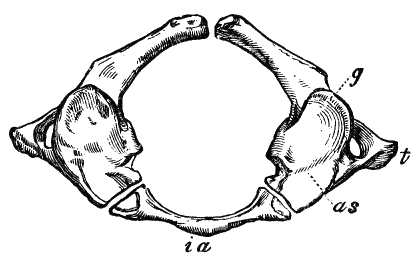

Image Source: Frank E. Beddard. The Cambridge Natural History, Volume X, Mammalia. Wikimedia Commons.
Here is a drawing of a human atlas, also known as the first cervical vertebrae C1. The image above depicts a young/not fully fused atlas, this is shown by the development of the anterior arch of the vertebral foramen (ia) not yet fusing to the anterior portion near the articular surface of the occipital condyles (as). Other notable landmarks include; the transverse process (t)— the transfers foramen directly medial to it, and the groove where the first spinal nerve and vertebral artery go through (g). The atlas has no vertebral body, no articular discs on its superior or inferior, and lacks a spinous process. On the posterior and medial surface of ia is the articulation for the dens of the C2.
Below is a fully fused C1/Atlas.

Image Source: Gliu. Atlante, prima vertebra cervicale, vista superiore. Wikimedia Commons.





